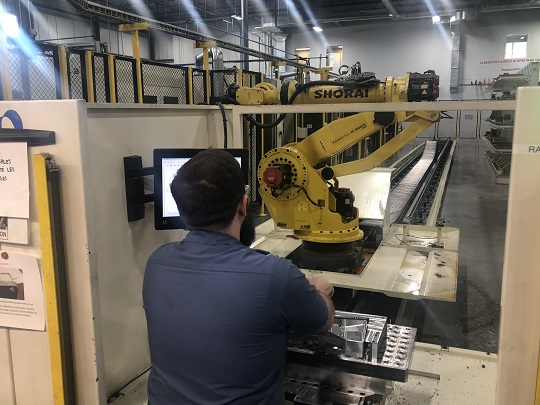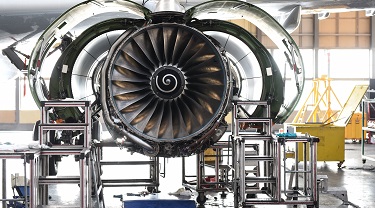Any company involved in the global aerospace industry’s supply chains is acutely aware that conditions are evolving rapidly. Smaller firms are less and less likely to be chosen as suppliers by the big aerospace companies, a development that can dangerously reduce their revenues.
The best response to this threat is to become bigger and more diverse. But doing so through organic sales growth is a slow, unpredictable process. A better solution is to expand the company by merging with or acquiring another business.
Abipa Canada (now Abipa International), a Quebec-based aerospace company with about $50 million in annual business, has specialized in precision machining of components for the industry since 1982. Under the leadership of CEO Jean Blondin, its management saw the threat looming and decided that a merger with an overseas company could not only solve the size problem, but also provide a greater international reach.

The aerospace sector and its supply chains
This shift to larger suppliers is happening because each manufacture-supplier relationship requires that the manufacturer exercise an enormous amount of oversight over the supplier, to ensure that that the supplier’s products meet all necessary quality standards. But a small supplier requires the same oversight as a large one, so a supply chain with numerous small companies is considerably more complicated and expensive than one that consists of a limited number of larger suppliers.
“The big aerospace companies are no longer looking for small-scale suppliers with a narrow product range,” says Alexandre Aubrey, a senior investment manager with Export Development Canada (EDC).
“They want larger partners that they can rely on to provide a robust, low-risk supply chain for most of their needs. Consequently, we’re seeing a lot of consolidation in the supply chains of both the global and the Canadian aerospace sectors,” he says.
Suppliers, like Abipa, have recognized this and are trying to grow into larger-scale businesses that’ll be attractive to partners for the major aerospace firms. This is often done via mergers and acquisitions (M&A), in which two separate companies combine into one entity. One company can purchase another outright (an acquisition) or unite with another firm to create a new business entity (a merger).
Setting up the merger
Any M&A deal requires a considerable commitment of time, resources and people. Well aware of this, Abipa took the time to establish solid operational and governance foundations before the company began the process.
“All our senior managers have large-company backgrounds,” says Blondin. “As a result, we were able to develop the governance maturity necessary for a merger. Our first step was to create an M&A committee within the board of directors, and that committee defined the characteristics we were looking for in a potential target company.
“Some of these criteria, for example, involved access to new customers, de-risking our supply chains, finding complementary technology, selecting a suitable geographical location and so on. Identifying those factors was crucial to the whole project, to make sure we chose the right partner. Once we’d done that, we were ready to look for potential merger prospects because we knew exactly what criteria they’d have to meet.”
You should also check out
Experts share best practices for managing and mitigating risk when conducting M&As in foreign markets.
Starting the process
For Abiba, the best merger target seemed to be Groupe ARM or ARM Group, which was similar in size to Abipa and specialized in the machining of mechanical parts for high-specification markets such as aerospace and defence. Better yet, Abipa and ARM Group had already discussed joining forces because they shared a vision of how the aerospace market was likely to evolve, and what the big manufacturers would expect from companies like theirs.
As a first step, Abipa visited all of ARM Group’s five sites in France and one in Morocco to carry out its due diligence. The resulting report went to Abipa’s M&A committee, which concluded that the two companies could be a good fit—ARM Group met the criteria the committee had established and had the knowledge, expertise and customer base that Abipa needed.
“The second thing we did was hire a major accounting firm to help us carry out the deal,” says Blondin. “They worked with us until we were a couple of days from signing the merger papers, but then everything went sideways.”
The pandemic and other challenges
The “sideways” was the unexpected outbreak of COVID-19 in March 2020. The merger process came to a halt for about six months while the global industry tried to assess what was going to happen. Eventually, some of the dust settled, but given the pandemic-related changes in the industry, Abipa decided it should redo its assessment and due diligence to decide whether the deal should still go forward.
“We felt that this had become an internal decision, so we didn’t need the accounting firm anymore,” says Blondin.
“We used our own in-house expertise and worked closely with our long-term financial partner, Fonds de solidarité FTQ, to reassess the numbers. FTQ’s people are experts in evaluation, so with their help, and with the help of our lawyers and tax specialists, we eventually finalized the deal and became Abipa International.”
Even so, the process presented numerous challenges despite all the expert help. “We discovered that doing an international merger isn’t easy,” observes Blondin.
“French law in this area is completely different from Canadian law, for example, and bringing two business cultures together is a lot of work. We learned a great deal, but it was a much more complex transaction than merging with a Canadian company would have been.”
EDC became involved at the financing stage of the merger by working with FTQ, the majority owner of Abipa. EDC came into the deal as an equity partner via our Investment Matching Program. “For the due diligence side of the transaction, we relied on FTQ’s assessment, which we reviewed and confirmed.”
You should also check out
After the merger
The importance of preparing for the post-merger or post-acquisition phase can’t be overemphasized, Blondin insists.
“This preparation should be done while you’re still working on the transaction,” he advises. “Leaving it till the papers are signed is far too late—once the deal is closed, everything happens fast and becomes complicated, so you need to plan every step in advance.
“Your post-signing strategy will define how the new company will operate in vital areas such as financial management, operations, human resources, communications and IT, so it’s important to get it right.”
To prepare for the post-merger stage, Abipa created a group to assess what was needed.
“The group included people from both companies, and we created a plan that covers short-term, medium-term and long-term needs,” says Blondin. “But for this process to work, you have to ensure that everybody understands where you’re going and that they’re committed to integrating the processes and approaches of the two companies.
“And in an international deal like ours, handling the cultural aspect is also very important, since you’re blending two ways of doing business that may be very different, but must adapt to working together,” he says
Six tips for a successful merger or acquisition
- Determine whether you have the necessary operational maturity in your company. If you don’t, take time to develop these resources before you forge ahead.
- Ensure that you have the right financial partners. Are they looking for short-term or long-term results? Are they ready for a commitment?
- Be sure you have a vision and a strategy for achieving that vision, as well as an instrument, like a committee, to support and advise you as you move forward.
- Get expert help early on such as legal, accounting, financial, negotiation and due diligence services. For international transactions, use advisory firms that have a presence or a partner in the country where your target company is located. EDC’s Export Help Hub covers the globe and can connect you with EDC trade advisors who can answer your questions, help you understand your challenges and help you find solutions for them.
- Do your homework about the target business’s country. Look at its political and economic landscape, legal and regulatory environment (e.g., Buy America in the United States), free trade agreements, banking system and business culture.
- Prepare a post-transaction strategy and use it to create a detailed plan for integrating the systems and operations of the two companies.
Read more
Want to find out more about Abipa and its merger story? Be sure to read Part 1 in this two-part series.
Continue series

Part 1 of 2 in series






